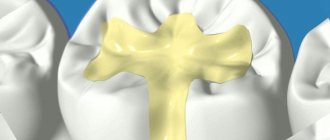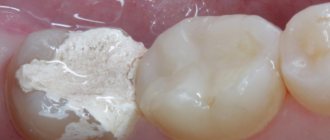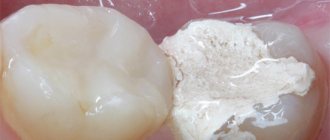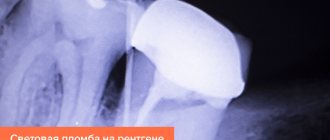The main principle of modern dentistry is the restoration and preservation of teeth, even the most problematic ones. Complex cases require more time than conventional caries filling. Such treatment usually includes several stages, and this requires the installation of a temporary filling.
At the Mitino Dental Center, appointments are conducted by experienced dentists. Our doctors successfully solve the most difficult problems, so before you decide to remove a tooth, try to save it. Make an appointment with us for a consultation and initial examination.
What is a temporary filling and what types does it come in?
This method of treatment is used for deep caries, pulpitis, and also for inflammatory processes in the root canals. A temporary filling means closing a tooth canal with a special compound that provides tightness and protection only for a certain time. This filling can be easily removed to continue the necessary treatment. That is why she is not able to withstand chewing loads for a long time. After completion of treatment, permanent filling must be carried out.
Such fillings have a safe and plastic composition that is easily distributed throughout the tooth cavity and dries quickly. Modern temporary filling material can be of the following types:
- artificial dentin - powder made from kaolin and zinc sulfate, which is diluted with plain water;
- cements – polymer, glass ionomer and zinc phosphate;
- dentin paste is an oil-based composition that contains zinc sulfate cement;
- Vinoxol is a zinc sulfate cement that has good strength;
- Karyosan - available in powder and liquid form.
These compounds have less protection from external influences than filling materials for permanent fillings. The type of paste is selected only by the doctor, based on the purpose and duration of treatment. Some formulations are designed for up to 1 week, while others last for several months.
What material is used
It is a light-curing composite that hardens when exposed to ultraviolet light. As a result of using this material, it turns out that the installed filling is light. In its original form, it is plastic, so the doctor can accurately copy the anatomical shape of the tooth, restoring its missing part. The composition includes heliocomposite, glass ceramics, stabilizers, and pigments that give a certain shade.
Advantages:
- Absolute safety and hypoallergenic.
- Non-toxic
- Withstands significant chewing load.
- Excellent polishability.
- They have the natural shine of healthy tooth enamel.
- Suitable for all patients.
Certain types of composite materials (for example, LuxaCore) contain zirconium dioxide, so we use them to fix intra-canal pins, which allow us to restore severely damaged teeth.
Why do they put a temporary filling?
In cases where there is a pathological process in the root canals, preliminary treatment with various medicinal compounds is required. In order for the medicine to remain in the canal for the required period, it is secured by installing a temporary filling. It also acts as a protective barrier against germs, bacteria and food debris that can get into the cavity of a diseased tooth.
Main indications for temporary tooth closure:
- Isolation of therapeutic antiseptic pad.
- Inflammation of the pulp (pulpitis). For this, arsenic paste is used to destroy the nerve of the tooth.
- Deep caries with damage to dentin.
- Periodontitis.
- Manufacturing of ceramic permanent inlay.
- The need to reschedule treatment.
Sometimes temporary filling is used for diagnostic purposes. If caries has damaged the deep layers, then it is impossible to find out exactly how damaged the pulp is. Therefore, the doctor must observe the tooth to choose the optimal treatment. The absence of pain indicates the vitality of the tooth, which means there is no need to remove the nerve.
Types of filling materials
The main requirements for the composition of fillings are harmlessness to the body, resistance to saliva, high plasticity for reliable sealing and sufficient strength to withstand chewing load for a certain period of time. In addition, they are easy to use and low in cost, which makes it possible to install temporary fillings several times during the treatment process.
Temporary fillings are distinguished by composition, polymerization method, curing method (chemical, light) and validity period. The choice of material directly depends on the purpose and time of its use. Additionally, attention is paid to the patient’s age, individual reactions of the body, the presence of dental structures in the oral cavity, etc. Modern dentistry has a large selection of zinc sulfate, zinc eugenol, carboxylate, and zinc phosphate compounds.
Zinc sulfate products:
- Artificial or water-based dentin is an aqueous mixture of zinc salts and kaolin. Affordable, but not strong enough material. Used for temporary fillings with a service life of up to 2 weeks.
- Oil dentin (dentin paste) – unlike artificial dentin, they are mixed with vegetable oils. Additionally, it acts as an antiseptic and has a long service life (can be used for up to 6 months). It has contraindications for use with arsenic pastes and for tooth restoration with composites (if the paste contains clove oil).
- Vinoxol is a zinc oxide guaiac cement, an analogue of artificial dentin, but with a longer service life. Suitable for installing temporary fillings for long-term use (up to six months).
Zinc-eugenol cement - a zinc oxide filling with the addition of eugenol can withstand increased chewing loads. Acts as a strong antiseptic and has an analgesic effect. Suitable for treating pulpitis and filling baby teeth. One of the common varieties is Karyosan, which is widely used to fill dental canals.
Carboxylate cement based on zinc, magnesium, and calcium oxides is a standard composition for installing a temporary filling. It hardens for a long time and has low strength. Due to its safety and high biocompatibility with dental tissues, it is widely used in pediatric dentistry.
Zinc phosphate cement is one of the oldest mineral cementitious compounds in dentistry. Has bactericidal properties. As a temporary filling, it is used for long-term sealing of a tooth for 2-3 weeks - mainly for sealing baby teeth or as a lining for permanent filling.
According to the period of use, temporary fillings are conventionally divided into 2 types of compositions:
- temporary dressings - applied for a period of no more than 1-14 days (aqueous dentin, dentin paste, Vinoxol);
- temporary fillings themselves are designed to last from several weeks to six months (carboxylates, glass ionomers, zinc-eugenol).
Installing a temporary filling
The decision to perform a temporary tooth filling is made by the dentist after a preliminary examination. X-ray diagnostics are also performed. The main rule is that in case of a purulent lesion, the tooth cavity should remain open. Only after complete elimination of the purulent contents, the tooth is temporarily closed with the installation of a therapeutic lining.
Installation takes no more than 30 minutes. The doctor performs the following manipulations:
- cleaning the canal with an antiseptic solution;
- laying down the medicinal composition (if necessary);
- installation of temporary filling material.
Since the temporary filling takes more time to completely harden, it is not recommended to eat for 2 hours after the procedure. Solid foods should be excluded from the menu for a day.
Important! A temporary filling may break due to exposure to saliva. Therefore, it is important to carefully monitor oral hygiene during the treatment period. Be sure to use antiseptic rinsing solutions.
If pain occurs, consult a doctor immediately!
Contraindications for installing a light filling
Such fillings have many advantages over conventional materials, but their installation is not possible in all cases. For example, having high plasticity, the material does not harden very quickly, and the doctor can fill the entire cavity while respecting the anatomical features.
Limitations and contraindications for placing a light-curing filling:
- Tooth location . In places with difficult access, where it is not possible to provide the necessary polymerization, which can negatively affect the quality of work. It would be preferable to install classic fillings.
- Long term use . It should be taken into account how long the patient needs a filling. For temporary wear, photopolymer materials are very expensive. It is better to install them as permanent ones.
- Age . Doctors do not recommend this procedure for children under 13 years of age. The physiological characteristics of the child’s body are increased salivation, incompletely formed tooth buds that are not able to withstand heavy loads. Also, the conditions for filling are that the child is unable to keep his mouth open for a long time. All this makes the procedure undesirable for young people.
How long does a temporary filling last?
The period depends on the diagnosis and the purpose of the temporary filling. This could be a few days or several months. Approximate terms for which the seal is placed:
- Nerve killing for pulpitis and deep caries - from 1 day to a week. This depends on the composition of the filling material.
- It takes 1–3 weeks to eliminate the inflammatory process in the tooth canal.
- When treating cysts, a temporary filling can last up to 2-3 months.
The decision is made only by the attending physician. But on average, a permanent filling is placed no later than after 10–14 days.
Important! You cannot wear a temporary filling for longer than the period prescribed by your dentist. This can lead to relapse of the pathological process.
Types of light seals
Some sources claim that light filling can only be done on the anterior group of teeth. This is not true. In modern reality, such filling is perfectly applicable to all groups of teeth. The only exceptions are places with difficult access, for example, “wisdom teeth” - figure eights. All types of light-curing fillings differ from each other in the composition of the filler, which determines their characteristics.
Macro-filled (for molars and premolars)
Contain large particles (macrophiles) of inorganic filler. Thanks to them, strength and roughness are imparted, and they also tend to lose their original color. Such fillings are applied to the chewing surface of the back teeth or on the inside of the dentition, where aesthetic qualities are not so important.
Microfilled (for the front group)
Consist of small particles. They have good color fastness, glossy surface stability, and can be sanded and polished well. However, they are very fragile. Most often used on the vestibular surface from canine to canine.
Nanohybrid
Combining in one material, ultrafine particles and large nanoclusters achieve high fullness. This structure provides maximum strength and allows for excellent aesthetics. They are characterized by excellent polishability and long lasting shine of the restoration. Universal newest light seals for 2020. Used for all types of restorations.
Features of care after temporary filling
Since temporary filling material is less durable than material for permanent fillings, excessive chewing and thermal stress can lead to its destruction. Therefore it is recommended:
- use a soft toothbrush;
- exclude the use of pastes with aggressive bleaching or polishing compounds;
- after eating, rinse your mouth with antibacterial rinses that were recommended by your doctor;
- exclude chewing gum and other viscous products.
Also prohibited are seeds, chips, and nuts.
How much does it cost to restore a front tooth with a light filling?
Restoring teeth in the anterior group with light filling is usually more expensive than teeth in the chewing group. The specialist will spend more time on the restoration of the front tooth. The shade of each layer of the composite is carefully selected, as they shine through one another, creating the natural transparency of the enamel. Thus, the cost of a light filling for a front tooth starts from 5,000 rubles. Not all clinics increase the price for filling front teeth; in many dentists it does not depend on what category the tooth belongs to. Likewise, at Implantmaster, the price of restoration with light-curing material does not depend on what kind of tooth it is. There is a comprehensive offer - 9500 rubles.
Author:
Possible complications
Common problems that may arise after installing a temporary filling include:
- Discomfort or soreness. On the first day, a little pain is normal. But if the pain intensifies, and even more so, soft tissue swelling appears, then consult a doctor earlier than scheduled. This symptom may indicate a possible infection, as well as the spread of the pathological process.
- Strange taste in mouth. May occur if a medicated pad is used. But if the taste is strong and unpleasant, then this means that the seal’s tightness is broken. Reinstallation required.
- Change in enamel color (darkening) or redness of the gums around the tooth. Alarm signal. A medical examination and x-ray are required.
The appearance of any severe discomfort should alert you. If you do not see a doctor on time, you can get complications, including tooth loss.
What to do if the filling falls out
Even if you follow all the dentist's recommendations, the filling may fall out. This mainly happens for two reasons:
- Low quality of the filling material used.
- Doctor's error during installation.
But in most cases, the filling falls out due to the fault of the patient himself. In any case, if a temporary filling falls out, you should definitely contact the doctor who installed it. Walking around with an open cavity in a tooth can cause it to become infected. It is also prohibited to cover it with cotton wool, chewing gum or other improvised materials.
Stages of installing a light seal
The way a light seal is installed is generally similar to that of a chemically cured material and consists of the following steps:
- Anesthesia - pain relief is carried out if necessary. Also, depending on the depth of the carious cavity, and this can be determined in advance by a targeted X-ray image, or better by (more accurate images and less radiation). These technologies are available at Implantmaster.
- Elimination of carious lesions. This procedure is carried out by our specialists only using a rubber dam (latex scarf) to ensure patient comfort and improve the quality of manipulation. A caries detector is also used to better determine the location of the lesion. If the pulp is affected, the canals are cleaned and a temporary filling is installed.
- Disinfection and drying of the cavity.
- Application of filling material and relief modeling. To achieve impeccable aesthetics and precise fixation of the restoration, Implantmaster uses a Labomed Magna dental microscope.
- Polymerization. Under the influence of ultraviolet lamp rays, the filling hardens.
- Grinding and polishing of the restoration. Using polishing rubber bands and discs, as well as a brush with paste, a naturally smooth surface of the filling is formed.
There is a difference between materials for the frontal and chewing teeth. Composites made of microparticles with high aesthetic properties are used on incisors and canines. For molars and premolars, load-resistant composites with large particles are used.
About prices for fillings
How much does a tooth filling cost in Moscow? The price of filling material depends on the brand, supplier, logistics, and terms of the contract with the clinic. Temporary fillings are cheaper than permanent fillings, and light-curing composites are more expensive than dental cements. The cost of caries treatment may include the cost of therapeutic and insulating pads.
In the capital, prices for dental services are higher than in the regions. Therefore, the Dento-Comfort clinic tries to protect its patients from unplanned expenses. Our doctors discuss methods and materials with patients in advance, and calculate the cost of filling teeth before treatment begins. Dento-comfort dentists will fill a tooth at the average price in Moscow. At the same time, the quality of work will be at a decent level. A comfortable and friendly atmosphere will be a bonus.
Stages of filling
Before installing a filling, the tooth must be prepared. The filling procedure includes:
- Removing hard and soft plaque. Hygienic cleaning is performed to stop further destruction of dental tissue by bacteria.
- Pain relief in the work area. Local anesthesia is used.
- Isolation of the tooth from saliva containing microorganisms. A latex gasket is used - rubber dam.
- Preparation of the affected tooth with a drill (removal of carious formations).
- Formation of the cavity.
- Disinfection with an antiseptic, etching of enamel with acid, coating with adhesive, drying of the treated cavity.
- Preparation of filling material. The dentist mixes some materials immediately before placing them in the dental cavity.
- Restoration of tooth shape. Lay the material layer by layer, compacting each layer tightly. When filling with light, the layers are sequentially irradiated with a UV lamp.
At the final stage, the doctor adjusts (grinds) the filling according to the bite.
The filling fell out - what to do?
If a filling falls out or begins to crumble, do not try to put it back in place. In this case, the best solution is to urgently make an appointment with a dentist. Depressurization of the cavity can cause infection, so you should not leave the situation for a long time without medical supervision. If there is no pain, you can use dentin paste purchased at the pharmacy as temporary protection for the exposed cavity. This plastic preparation will make it possible to temporarily close the depressurized area and protect it from infection. This solution allows you to delay visiting the dentist for a couple of days.
Sealing
Filling is the final stage of therapeutic treatment, at which the anatomical shape and working capabilities of the tooth are restored. Restoration is performed with composite materials and dental cements. In Moscow, the cost of a filling per tooth varies from 2 to 10 thousand rubles. The difference in price is explained by the characteristics of the filling material and the popularity of the clinics. Dento-comfort dentistry is a combination of average prices and premium quality services. We are not inferior to the professionalism and service of expert dental centers, but we strive to make treatment affordable. Thoughtful procurement, established contacts with suppliers, and cost optimization help us maintain our position in the mid-price segment.










